
In astronomy, declination is one of the two angles that locate a point on the celestial sphere in the equatorial coordinate system, the other being hour angle. Declination's angle is measured north or south of the celestial equator, along the hour circle passing through the point in question.

The Royal Observatory, Greenwich is an observatory situated on a hill in Greenwich Park in south east London, overlooking the River Thames to the north. It played a major role in the history of astronomy and navigation, and because the Prime Meridian passes through it, it gave its name to Greenwich Mean Time, the precursor to today's Coordinated Universal Time (UTC). The ROG has the IAU observatory code of 000, the first in the list. ROG, the National Maritime Museum, the Queen's House and the clipper ship Cutty Sark are collectively designated Royal Museums Greenwich.

The north and south celestial poles are the two imaginary points in the sky where Earth's axis of rotation, indefinitely extended, intersects the celestial sphere. The north and south celestial poles appear permanently directly overhead to observers at Earth's North Pole and South Pole, respectively. As Earth spins on its axis, the two celestial poles remain fixed in the sky, and all other celestial points appear to rotate around them, completing one circuit per day.

Proper motion is the astrometric measure of the observed changes in the apparent places of stars or other celestial objects in the sky, as seen from the center of mass of the Solar System, compared to the abstract background of the more distant stars.
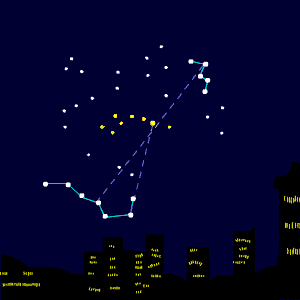
A circumpolar star is a star, as viewed from a given latitude on Earth, that never sets below the horizon due to its apparent proximity to one of the celestial poles. Circumpolar stars are therefore visible from said location toward the nearest pole for the entire night on every night of the year. Others are called seasonal stars.
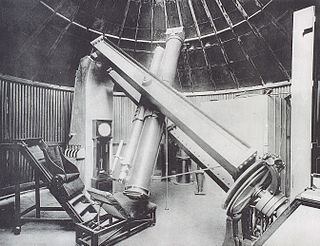
The Carte du Ciel and the Astrographic Catalogue were two distinct but connected components of a massive international astronomical project, initiated in the late 19th century, to catalogue and map the positions of millions of stars as faint as 11th or 12th magnitude. Twenty observatories from around the world participated in exposing and measuring more than 22,000 (glass) photographic plates in an enormous observing programme extending over several decades. Despite, or because of, its vast scale, the project was only ever partially successful – the Carte du Ciel component was never completed, and for almost half a century the Astrographic Catalogue part was largely ignored. However, the appearance of the Hipparcos Catalogue in 1997 has led to an important development in the use of this historical plate material.

A theodolite is a precision optical instrument for measuring angles between designated visible points in the horizontal and vertical planes. The traditional use has been for land surveying, but it is also used extensively for building and infrastructure construction, and some specialized applications such as meteorology and rocket launching.
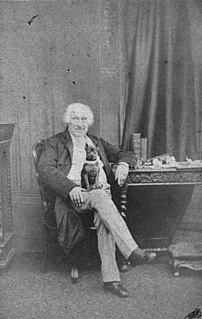
Sir James South FRS FRSE PRAS FLS LLD was a British astronomer.
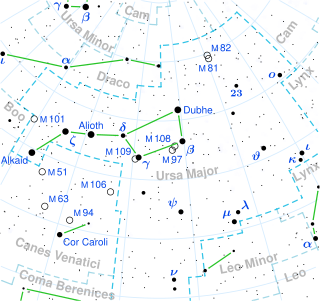
Groombridge 1830 is a star in the constellation Ursa Major.

Stephen Groombridge FRS was a British merchant and astronomer.

Edward Troughton FRS FRSE FAS was a British instrument maker who was notable for making telescopes and other astronomical instruments.

Groombridge 1618 is a star in the northern constellation Ursa Major. With an apparent visual magnitude of +6.6, it lies at or below the threshold of stars visible to the naked eye for an average observer. It is relatively close to Earth, at 15.88 light years. This is a main sequence star of spectral type K7.5 Ve, having just 67% of the Sun's mass. There is a suspected planetary companion with an orbital period of 122 days.

Groombridge 34 is a binary star system in the northern constellation of Andromeda. It was listed as entry number 34 in A Catalogue of Circumpolar Stars, published posthumously in 1838 by British astronomer Stephen Groombridge. Based upon parallax measurements taken by the Gaia spacecraft, the system is located about 11.6 light-years from the Sun. This positions the pair among the nearest stars to the Solar System.

The meridian circle is an instrument for timing of the passage of stars across the local meridian, an event known as a culmination, while at the same time measuring their angular distance from the nadir. These are special purpose telescopes mounted so as to allow pointing only in the meridian, the great circle through the north point of the horizon, the north celestial pole, the zenith, the south point of the horizon, the south celestial pole, and the nadir. Meridian telescopes rely on the rotation of the sky to bring objects into their field of view and are mounted on a fixed, horizontal, east–west axis.

A star chart or star map, also called a sky chart or sky map, is a map of the night sky. Astronomers divide these into grids to use them more easily. They are used to identify and locate constellations and astronomical objects such as stars, nebulae, and galaxies. They have been used for human navigation since time immemorial. Note that a star chart differs from an astronomical catalog, which is a listing or tabulation of astronomical objects for a particular purpose. Tools utilizing a star chart include the astrolabe and planisphere.
The Indestructibles was the name given by ancient Egyptian astronomers to two bright stars which, at that time, could always be seen circling the North Pole. The name is directly related to Egyptian belief in constant North as a portal to heaven for pharaohs, and the stars' close association with eternity and the afterlife. These circumpolar stars are now known as Kochab, in the bowl of Ursa Minor or, the Little Dipper, and Mizar, in Ursa Major, at the middle of the handle of the Big Dipper.
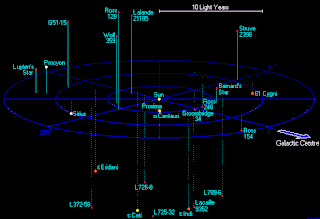
A light-year, alternatively spelt lightyear, is a large unit of length used to express astronomical distances, and is equivalent to about 9.46 trillion kilometers (9.46×1012 km), or 5.88 trillion miles (5.88×1012 mi). As defined by the International Astronomical Union (IAU), a light-year is the distance that light travels in vacuum in one Julian year (365.25 days). Because it includes the time-measurement word "year", the term light-year is sometimes misinterpreted as a unit of time.

The Royal Observatory, Cape of Good Hope, is the oldest continuously existing scientific institution in South Africa. Founded by the British Board of Longitude in 1820, it now forms the headquarters building of the South African Astronomical Observatory.

Thomas Glanville Taylor was an English astronomer who worked extensively at the Madras Observatory and produced the Madras Catalogue of Stars from around 1831 to 1839.
William Stephen Jacob (1813–1862) was an English immigrant astronomer in India, who acted as the director of the Madras Observatory from 1848 to 1859. His early claim of 1855 to have detected an exoplanet, in orbit around 70 Ophiuchi, is now thought to have been mistaken.

















